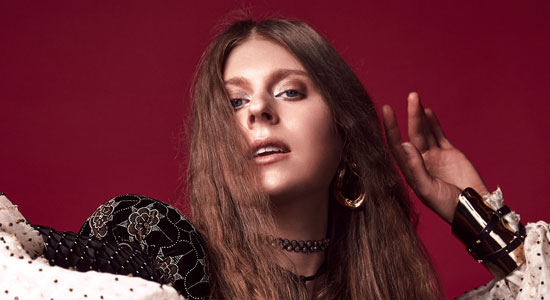
Lydia Ainsworth explores the subconscious on Darling Of The Afterglow
The songs Lydia Ainsworth composes to support her poignant explorations of love gone wrong are delicately balanced between the warm, romantic sounds of classical music and the jarring, icy tones of modern electronica. On Darling Of The Afterglow, the Toronto resident’s second LP, she floats down into subterranean currents of the subconscious to investigate the border between dreams and nightmares.
“This album is a scrapbook of my experiences over the past few years,” she says. “The music can be forlorn and despondent and, perhaps, hinting at mortality. I’m always exploring loneliness, isolation and the desire to communicate more honestly. I try to convey our internal dialogue and the way we censor ourselves in order to be understood. While I was writing the songs, I was inspired by the story of a woman who had a stroke. She lost the ability to perceive three dimensions. She saw in two dimensions, and although she could function in the world, every moment was a new moment. She couldn’t retain the memories of anything she did. That sparked the idea of selective memory. Are we selective in what we remember? What are we choosing to ‘not see’ in our day-to-day lives?”
That theme is frequently revisited on Darling Of The Afterglow. Glistening keyboards and moaning electric bass support Ainsworth’s breathless voice on “Open Doors,” an ode to a man who closes his eyes to the love that’s been standing in front of him. On “Afterglow,” her impressive multitracked vocals wander through outer space, searching for a release that may be more spiritual than physical. The effect is otherworldly.
“I studied film scoring at NYU with Joan La Barbara, who uses extended vocal techniques—trills, whispers, cries and exhaled notes,” she says. “On this album, I used my voice to create vocal samples to add texture to the tracks. The human voice is a magical thing. I’m always blown away by the power you can get when you have voices blending together.”
Ainsworth thought she was going to be an orchestral composer or a writer of film scores. Despite her impressive vocal abilities, she was always a shy performer, even though she loved choral music and dreamed of being a singer and a songwriter.
“I got a six-CD stereo and listened to music all hours of the day and night, which my mother didn’t like,” she says. “In high school, I played cello, sitting in the back of the orchestra, observing the other players and becoming obsessed with the idea of writing for an orchestra. While working on a score for an experimental film in college, the director encouraged me to add vocals to one of the tracks. After the film was done, he asked me to perform at the wrap party. I only had that one song, so I quickly wrote a few more and put together a band. We played them, and by the end of the night, I realized how much I loved writing songs and playing for a live audience. I’ve never stopped.”
—j. poet






